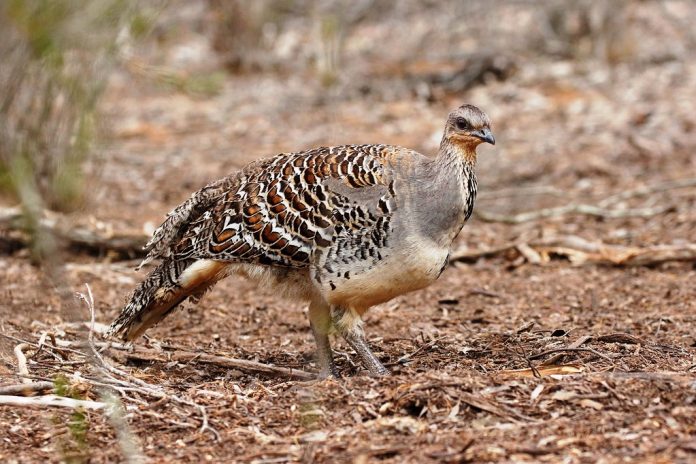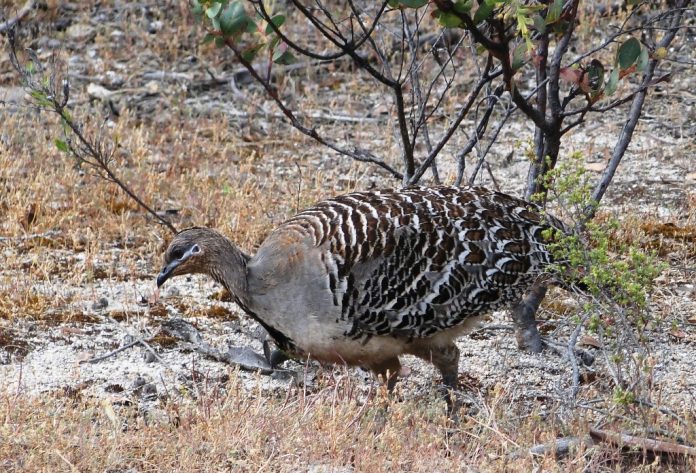The Malleefowl (Leipoa ocellata) is faced with a life of toil from the moment it hatches underground. The chick must struggle up through a meter of loose sand to the surface of the nest mound. When it emerges, it is completely on its own, very weak, and barely able to tumble down to shelter. However, within 24 hours, it can fly, for although its body is downy at hatching, its wings are well-feathered.
Malleefowl mate for life yet are habitually solitary; the male is bound to maintain the nest mound almost year-round while the female wanders locally in search of the food needed to sustain her production of eggs. Hence, the two seldom meet away from the nest. Each pair occupies an enduring territory of 40–70 hectares of natural mallee, and it may have up to four or five scattered nest mounds, only one of which is used in a season.
Beginning in autumn, both birds may build the mound, first scraping out an old one, unhatched eggs and all, to a depth of one meter and a diameter of three to four meters. Into the hole, they then scrape leaf litter, twigs, and bark, radiating up to 25 meters out from the nest, working the material into windrows, then kicking it backward in powerful strokes.
An egg chamber is then dug into the top of the heap, and, after the rain has wet it, the whole thing is covered with sand, forming a mound some five meters in diameter and 1.5 meters high. At this stage, after about four months of intermittent work, the mound is ready for eggs. The female visits the mound only to lay eggs from then on, depositing them one per visit early in the morning in holes dug for her and then filled in by the male.
The number of eggs that she lays in a season is related to the interval between eggs and the length of the laying period, both of which are affected by rainfall. In drought, the interval between eggs increases, from about two days to over two weeks, and the laying period decreases. And if autumn and winter are dry during nest building, the mounds are abandoned altogether.
Throughout the breeding season, the male maintains the nest mound and defends the area around it. It is his responsibility to keep the egg chamber of fermenting vegetation at a constant temperature of 33°C. Early in the season, the eggs are incubated by the heat of fermentation and, later, as fermentation wanes, by the heat of the summer sun.
The male tests the temperature of the mound with the inside of his mouth, first pecking rapidly once or twice and then driving his partly open bill into the sand up to his eyes for a few seconds. Both sexes have this capacity, but the male does it the most frequently. If the heat generated from fermentation early in the season is too intense, the male kicks out material from the egg chamber to release it, and if the summer sun is too hot later on, he piles insulating sand on top and periodically opens the mound up for a short time in the cool of the very early morning.
In the autumn, the male scoops out the mound each morning to expose the interior to the sun’s rays, and then rebuilds the mound in the afternoon. If opening the mound in unsuitable weather is likely to alter the correct internal temperature, the male will drive the female away even when she is ready to lay an egg.
The malleefowl is a quiet, unobtrusive bird that feeds on seeds on the ground, principally acacia and the buds of herbs, and some insects. Although it will drink if water is at hand, it normally lives without it. A dominant runner, it rarely flies but does flap up into low trees to roost or take refuge. Nowadays, malleefowl are fairly abundant only in remnant pockets of mallee.
Although foxes dig out mounds for eggs and sheep graze the Malleefowl’s seed plants, the real cause of the decline seems to be the clearing of its habitat for crops and grazing. The bird is also known as a lowan or gnow. Malleefowl is about 600 mm in length. Adults: both sexes are similar, but the crown and nape are streaked dusky, with a slight crest. Back of neck and upper back grey, grading into heavy black, white, and buff-brown moltting and ocellations over back, scapular, and wing coverts.
Flight feathers and tail mid-brownish grey barred dusky and tipped off-white on outer tail feathers. Face mid-grey with a white line under the eye; chin russet. Throat buff and foreneck gray, with central black streaking coalescing in a broad black stripe to the center of the breast. Lower breast and belly cream-white; flanks barred black; crissum cream-buff. The eye is orange-brown, and the bill is slate-grey. Feet and toes leaden; claws dusky. The Downy young is gray-brown, finely freckled, and peppered with black and buff on the upper parts.
Malleefowl territorial call is a loud booming; in threat, a sharp grunt; and when the pair is together, a soft, drawn-out cluck. NESTING Begins mound construction in autumn; lays September to the following March-April. Nest a mound of decomposing vegetable liner covered with sand 1.5 m high and 5 m in diameter, swept into a hole in the ground one m deep and 3-4 m in diameter, with an egg chamber 500 x 500 mm filled with wee rouingliuer in the cop.
Also, see: The Amazing Photos of Flying Peacocks

Eggs: Can found 5 to 33, but normally 15-24; fragile pink but soon stained brown; long-oval, about 92 x 61 mm, but variable. The incubation period is about 49-50 days, depending on the temperature of the mound. The young independent and free-running in hatching. Malleefowl are found throughout dry inland southern Australia, from Pilliga, New South Wales, to the west coast. Mostly found in mallee and ocher dry scrubs in a semi-arid zone, but enters wetter mallee heaths at the southern edge of the range. No races.

